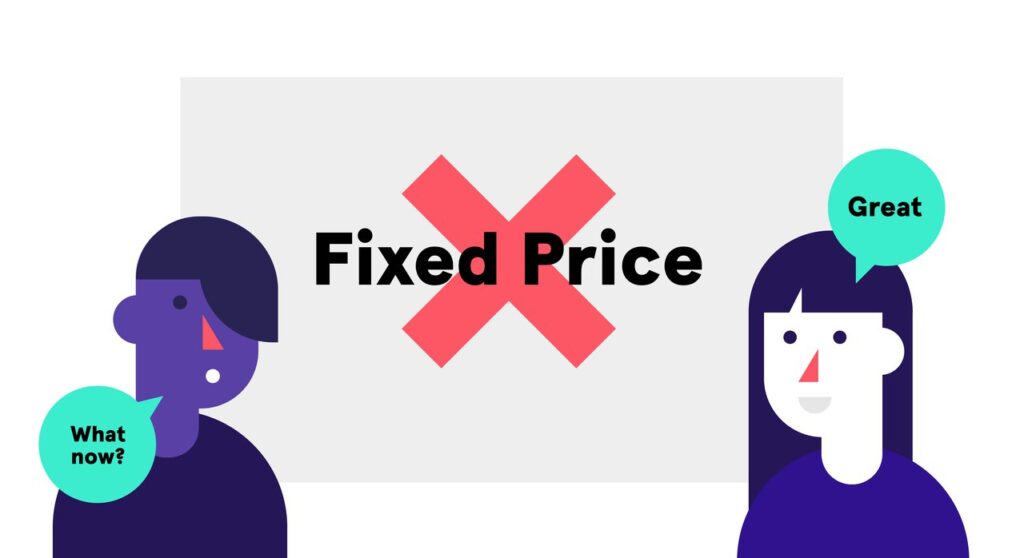
14 Jan Fixed Price vs Time & Material Cooperation: Which One Better Suits Your Project?
Fixed Price vs Time & Material Cooperation: Which One Better Suits Your Project?
Suppose you decide to create a new piece of software, develop an innovative application that will wow your customers, or want to launch a product redesign.
In that case, you may find it more efficient to hire an external provider rather than do everything yourself.
Contracting an experienced outsourcing partner to deliver the project might not be an easy task, but it’s a guarantee that you will get a superior product.
When hiring your dedicated team, you may come across various pricing models. Choosing the one that best suits your business needs, in the long run, can streamline the development process and save you from troubles and financial losses.
We decided to compare two of the most popular cooperation models — fixed price and time & material contracts — to help you make the right choice.
Fixed Price

This model implies that the client agrees to pay a firm price to the service provider in exchange for delivering specific results.
Therefore, the project’s budget, development timeline, and functions to be implemented are well-defined before the works start.
Fixed-price contracts gained wide popularity because they make companies feel safe and secure. The clients know they will only pay a single fee covering everything from features and materials to troubleshooting and maintenance costs.
They are content that they won’t be compelled to pay extra money even though the project may consume more time and effort than initially planned.
On the other hand, the contractors can benefit from clear and consistent agreement with precise requirements.
In the fixed price model, the delivery schedule, list of services, and their costs are approved initially and can not be changed later on.
If the customer decides to implement some additional features, they will have to negotiate separately all the adjustments not covered by the original contract.
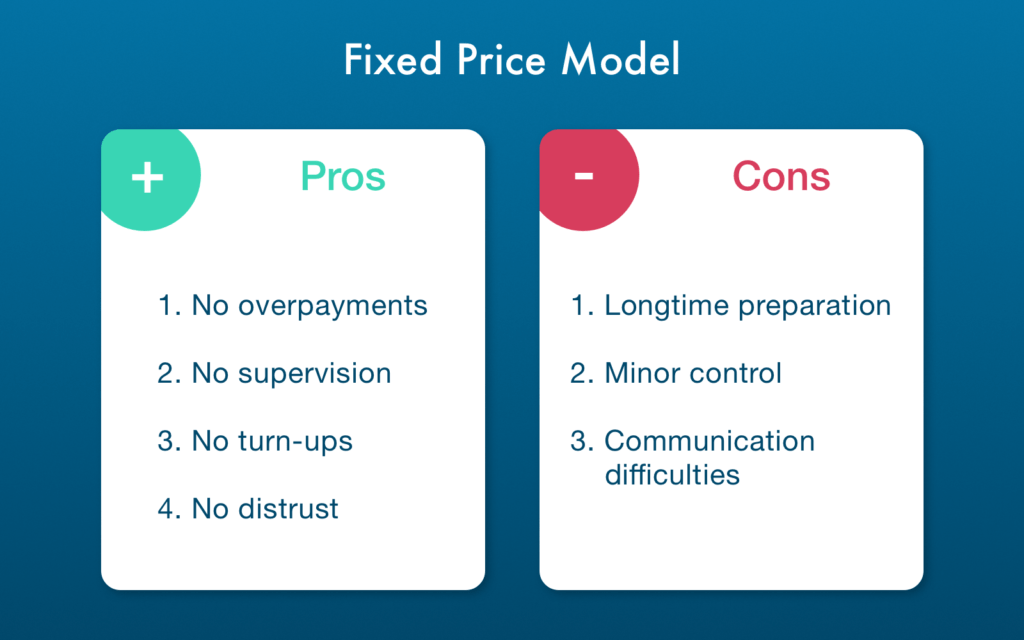
Pros of Fixed Price Model
The fixed price approach proves to be one of the most beneficial billing models for clients and vendors alike. Among the top advantages of this method are the following:
Set Budget
As both parties are well aware of the product development cost before signing the contract, there is no room for any additional expenses out of nowhere.
This helps businesses eliminate potential risks and prevents them from overspending their budget.
This means the client won’t have to carry the burden associated with additional production supplies, billable staff wages, licensing, and permits as the vendor will take care of these issues.
On the other hand, the software company can rest assured that they will get paid for their work even if the project completion is unexpectedly quick and smooth.
Pre-Agreed Timeline
Based on the final scope and detailed functionality, the tech team can easily calculate the time needed to present the client with the ready product.
They quickly develop strong motivation with a clear plan and definite deadline, which drives their progress.
As for the customers, this type of agreement allows them to keep abreast of the project milestones and detect any delays in the delivery.
Easy Management
The fixed price model enables the service provider to work on the product development reasonably independently.
Since everything is planned out upfront, there is little to no interference from the commissioning party. The client can hand over project management responsibilities to the software house and wait to complete the work.
Predictable Outcomes
Negotiating tasks, details, and conditions early on allows the client and the outsourcing company to quickly develop a clear and shared vision of the end product.
So from the outset, both parties are on the same page about the desired outcomes. Not only does that eliminate possible turn-ups, but it also guarantees a high degree of compliance among everyone involved.
Cons of Fixed Price Model
The partnership framework based on the fixed price model may look like a perfect option at first, but a closer examination reveals some highly uncertain prospects:
Lack of Flexibility
The market is constantly evolving, and to stay on top of the game, businesses need to change along with it.
Thus, at some point, the client may realise that certain functionality agreed upon in the contract has already become redundant. They might also be eager to develop other features instead.
However, stringent conditions imposed by a fixed-price contract leave zero room for improvements or changes.
Any alterations of project specs or deliverables will trigger a new round of negotiations, disrupting the planned schedule and potentially leading to financial losses.
Compromised Quality
If the original arrangement wasn’t detailed enough, it might cause misunderstandings which can hurt the result.
As the development team remains clamped inside the tight conditions of the contract, they are likely to ignore some inconsistencies to meet deadlines.
The shortcuts they rush to adhere to the schedule can significantly affect its quality. This can result in something entirely different from what the client expected.
Elaborate Planning
The fixed price cooperation model requires full-grown technical planning. Before even entering into a partnership, both parties need to have a clear idea of what they will build.
The team has to define every aspect of the development process at this stage, from the product capacity, material and human resource allocation, to scheduling and provisioning.
The initiation phase in the fixed price model is about delineating the project down to every last detail. The client also has to consider technical difficulties that may arise on the way and try to mitigate the risks beforehand.
This means that the planning stage will likely take up much more time than other IT projects.
Cost-Intensive Process
Even though the scope of work is defined initially, there’s still a chance that some deviations can crop up. That’s why contractors tend to increase the predicted budget by a safety margin in case of unexpected issues.
They also usually overestimate the time needed to present the ready product, so as a client, you end up paying a lot more than initially projected.
Time and Material
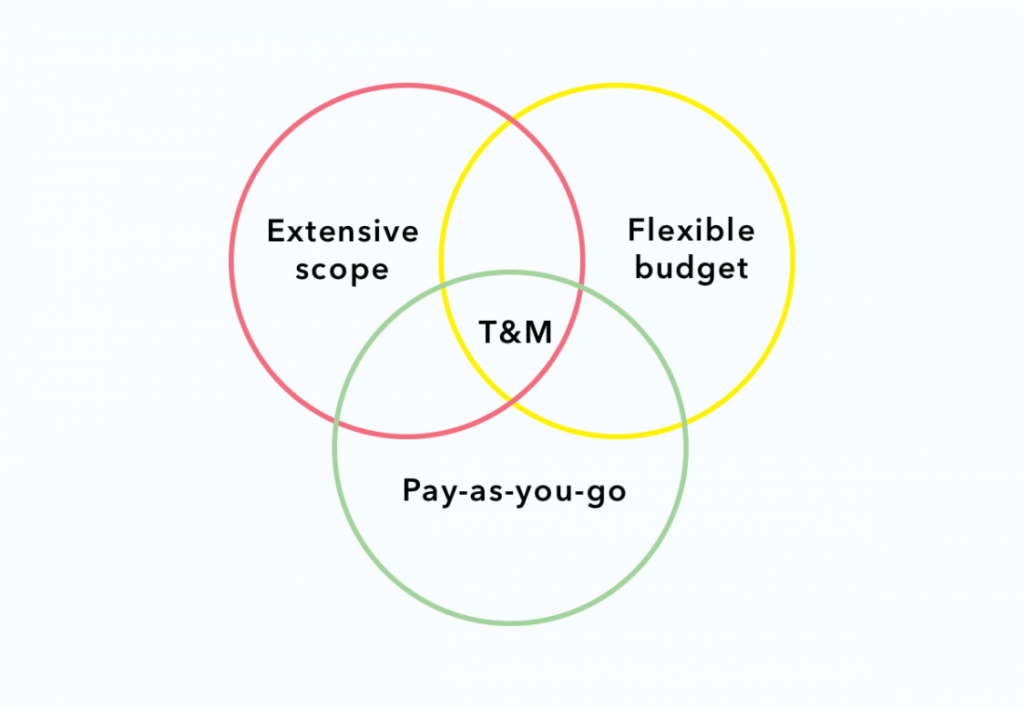
Building a digital product rarely goes step by step according to a predetermined plan. And that’s when the time and material model comes to the fore.
This cooperation type assumes that billing is based on the actual time and cost of materials invested in the development process.
This includes the work done by programmers, designers, QA engineers, and other tech specialists whose expertise may be required to deliver a quality result.
Product development is a dynamic process. New ideas often emerge, business models change, and functionality has to be altered to pivot on the up-to-date market and user insights.
Therefore, the T&M model grants clients flexibility, allowing them to shift priorities on the fly to accommodate the immediate need.
Close vendor-client collaboration is another reason for such agreements a widespread IT outsourcing practice.
With ongoing adjustments and evolving product specifications, the product owner is deeply involved in the design and development processes and can instantly evaluate the effect of the work.
As for the outsourcing company under the T&M contract is not limited by the strict budget and timeline and can thus pay more attention to the specific aspects of the project’s scope. They also take more interest in seeking a practical solution and building a superior product.
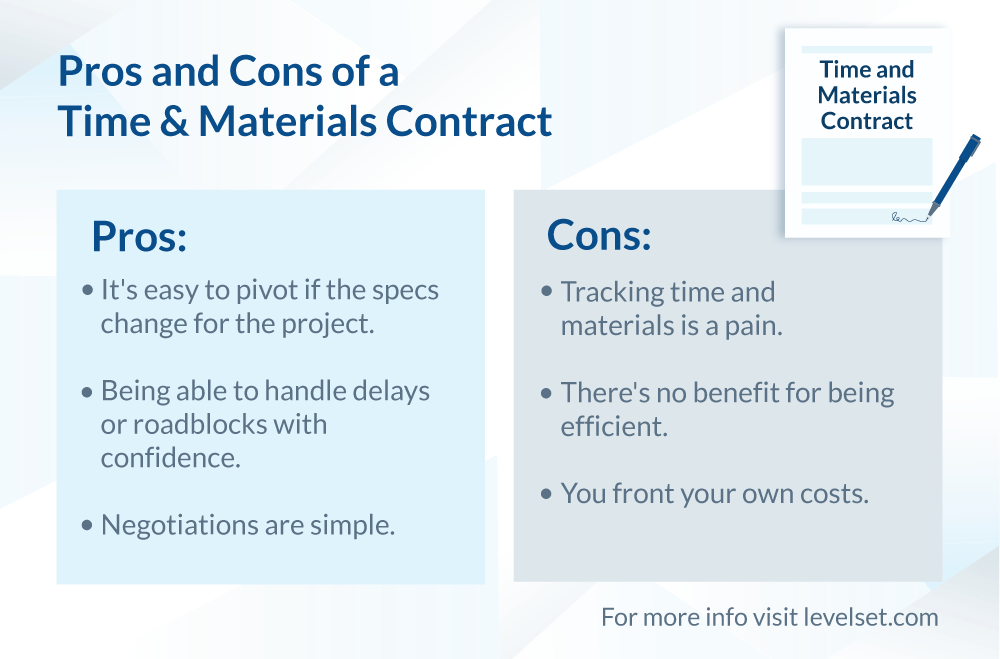
Pros of Time and Material Model
Compared to the fixed price model, the most significant value of T&M arrangements is that there is no need to define all the assumptions from the outset. Among other advantages, we may highlight the following:
Dynamic Work Scope
The T&M model provides increased flexibility, so it can adjust requirements, shift goals and implement additional features at any time.
Suppose there’s a sudden need to rework some parts of the project, introduce radically new designs, or make some improvements to ensure a better customer experience. In that case, the team can modify the scope throughout the process.
With T&M contracts, the parties are not bound to stick to the original software project plan. Therefore, they can easily change not only the project specifications but the method of work as well.
This can vary from calibrating the workload to rethinking the budget and timeframes. Moreover, the client company has the flexibility to scale up or down the team in line with their current needs and objectives.
Quick Start
Project commencement under this type of contract is pretty simple because it requires less planning. Once the parties finalise the hourly rate and estimated scope of work, the development team can immediately get into gear.
It’s enough to define just the product’s essential functions since you can determine concepts and specifications during the development process itself.
Viable Product
The T&M approach gives plenty of room to experiment. Moreover, as work takes place in sprints after each milestone, developers can evaluate the effectiveness of their efforts by testing the concept with real users.
The team can shift directions and change the product specs as many times as possible to provide the best value to the end customers.
Market feedback and continuous iterations help build a profitable product that fully caters to the target audience’s needs.
Cons of Time and Material Model
The T&M cooperation model is a perfect solution for those looking for flexibility and performance efficiency.
However, it also has some drawbacks one has to consider before signing the deal:
Low Budgeting Control
Agreeing to this type of cooperation may risk your budget, as it is hard to make a sharp estimation of the development costs.
The client and the software agency can agree on the hourly rate, but it is difficult to predict how long it will take to complete the project.
While controlling the budget of a T&M arrangement is a challenging task, the client company can still have their say in that regard.
This type of cooperation allows them to track how much time the team has been working on a given task, how many tech specialists were involved, and what resources were used.
Uncertain Deadline
The T&M model is based on Agile principles. It means that development proceeds by small incremental advances, and sometimes, it is hard to see the whole picture at once.
Moreover, because the product requirement can change on the go, defining an exact release date may be quite a complicated task. That’s why forecasting the time limits of such projects is usually easier said than done.
Deep Involvement
Intensive collaboration between the outsourcing company and the commissioning party can be positive or negative.
Not every client is ready to devote significant time and resources to constant supervision of task progress and active involvement in the development process.
Therefore, this model best suits business owners who want to have complete control over each stage of the product life cycle.
On the other hand, regular meetings with the team are one of the underlying principles of the T&M approach.
They ensure that the overall strategy is up-to-date and the engineering team moves forward in the right direction.
Which Model to Choose?
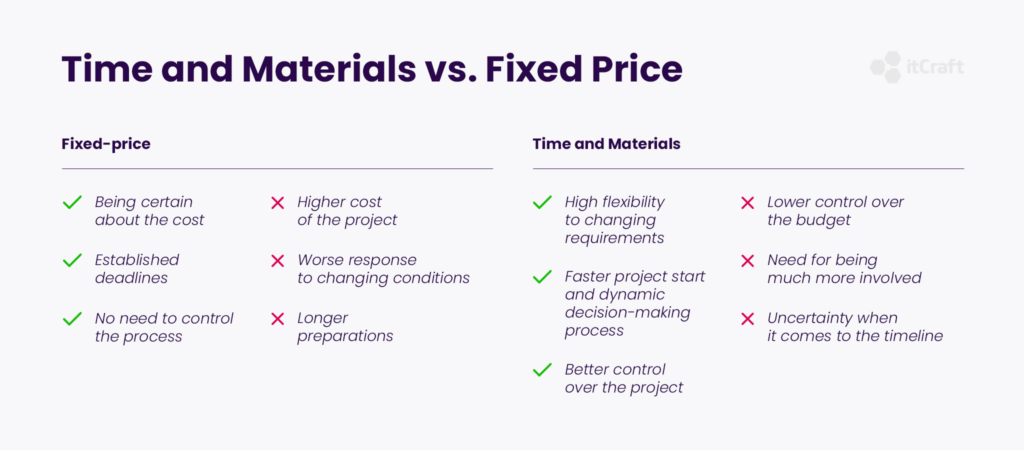
Knowing the benefits and drawbacks of each cooperation type, you now should make a more weighted decision.
As a rule of thumb, fixed-price contracts are better matched to the needs of startups and SMEs looking for one-off aid in digital product creation.
The time and material model, on the other hand, works best for companies pursuing long-term, complex, and large-scale projects.
Additionally, you might benefit from a fixed price agreement if:
- It is a small well-thought project with distinct features, like a company website or a landing page.
- You have a clear vision of what you want to build and communicate that idea to the development team.
- The specifications stated in the original arrangement are not likely to change over time.
- You want to test the feasibility of your concept and therefore plan to build MVP first.
- The budget allocated for software development can not exceed the authorised spending limit.
- You expect the product to be released within 3 to 5 months.
It would help if you opted for a time and materials contract in the following cases:
- You have a raw or innovative product idea, and continuous iterations are the key to reaching its full potential.
- There are no stringent limitations in terms of budgeting or development timeframe.
- You value the freedom to experiment and out-of-box thinking more than uniformity and predictable results.
- The product you aim to create is of high complexity and scalability.
- You are willing to participate in the development process and are eager to work closely together with the engineering team.
Takeaway
Choosing the best cooperation model largely depends on the specifics of your product.
Before entering into a partnership with the outsourcing firm, you should do the groundwork to define the extent of the project and think through the development timeline.
These two aspects will give you an idea of which way to go next.
But regardless of what route you take, finding a reliable tech partner is what makes both fixed price and time and material approach genuinely thrive.
The post Fixed Price vs Time & Material Cooperation: Which One Better Suits Your Project? is by Stuart and appeared first on Inkbot Design.


